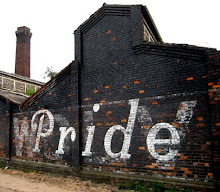 Passages to the train and bus stations from the Wednesfield Road,
Passages to the train and bus stations from the Wednesfield Road,Sun Street and the Corn Mill, accessing the canal. Artist involement at the Corn Mill site?
Walking under riveted beams of the rail bridge over the Wednesfield Road, I noticed the 113 plaque and then around to the arched passageway, with wrought ironwork and white tiled walls with ghosted graffitti , then over worn pavings that looked like large flat cobbles and up to the train station, opening out to the familiar sight of the multi storey car park with its dark red lines connecting floors and then down to matching bollards. through the fence I saw the unmistakeable sign of 'Fellows Morton and Clayton' on the back face of the British Waterways Depot.
Walking up toward the bus station and over the Ring Road St. Davids I forgot that the bridge overran the canal and I got to familiar blue railings. I tried to make it down here to the canal, but couldn't. I took a photo and reminded myself of this by a shadow cast by the bright sun of the railings down to the towpath at about a forty five degree angle. This made me realise that where I felt I wanted to gain access to, or where it seemed logical to walk, I couldn't. The canal here could be an interesting entrance and exit point to the stations and the future interchange. Again this area is very restrictive in pedestrian flow and the opportunities here seem to be great and exciting.
I retraced my steps and to my original starting point and wondered how far it is to the nearest obvious access to the canal. Perhaps I should count my paces next time, though I believe it was quite a lot.
I decided then to walk down Sun Street. Whether it is the name 'Sun Street I don't know, but there is something interesting about this street , shaped like a giant 'W' on a street plan.
On arriving upon the Great Western pub and with the Low Level Station to my left I began to realise the importance of Sun Street as a linking road to the city centre. I noticed an intermittent stream of pedestrians alongside the arch patterned blue brick railway wall toward the Wednesfield road. Continuing under the bridge, up the cobbled street, I got an overwhelming sense of an important period in industriality totally specific to Wolverhampton. Then, before me was the burnt out Corn Mill. I was reminded of Councillor Neville Patten's comments in the Express and Star; “it’s a great loss to the city as the building was associated with Wolverhampton’s industrial heritage. It remains to be seen what the developers will be able to do now. Perhaps the building can still be salvaged or it may have to be demolished completely.”
I'm not aware of what is happening to the mill, but perhaps artist involvent can help to maintain a sense of this place if the building is demolished in whatever capacity. This wormhole view of Wolverhampton's identity cannot be lost.
On my return I noticed a square of concrete marked with a date, filling in a gap in the bridge, that cracks slightly to monitor its movement. It was telling me that this landscape is breathing and that the aim shouldn't be to suffocate it or deny it sympathy.








+copy.jpg)

No comments:
Post a Comment